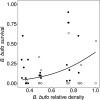Numbers, neighbors, and hungry predators: What makes chemically defended aposematic prey susceptible to predation?
- PMID: 33391674
- PMCID: PMC7771146
- DOI: 10.1002/ece3.6956
Numbers, neighbors, and hungry predators: What makes chemically defended aposematic prey susceptible to predation?
Abstract
Many chemically defended aposematic species are characterized by relatively low toxin levels, which enables predators to include them in their diets under certain circumstances. Knowledge of the conditions governing the survival of such prey animals-especially in the context of the co-occurrence of similar but undefended prey, which may result in mimicry-like interactions-is crucial for understanding the initial evolution of aposematism. In a one-month outdoor experiment using fish (the common carp Cyprinus carpio) as predators, we examined the survival of moderately defended aposematic tadpole prey (the European common toad Bufo bufo) with varying absolute densities in single-species prey systems or varying relative densities in two-species prey systems containing morphologically similar but undefended prey (the European common frog Rana temporaria). The density effects were investigated in conjunction with the hunger levels of the predator, which were manipulated by means of the addition of alternative (nontadpole) food. The survival of the B. bufo tadpoles was promoted by increasing their absolute density in the single-species prey systems, increasing their relative density in the two-species prey systems, and providing ample alternative food for the predator. Hungry predators eliminated all R. temporaria individuals regardless of their proportion in the prey community; in treatments with ample alternative food, high relative B. bufo density supported R. temporaria survival. The results demonstrated that moderately defended prey did benefit from high population densities (both absolute and relative), even under long-term predation pressure. However, the physiological state of the predator was a crucial factor in the survival of moderately defended prey. While the availability of alternative prey in general should promote the spread and maintenance of aposematism, the results indicated that the resemblance between the co-occurring defended and undefended prey may impose mortality costs on the defended model species, even in the absence of actual mimicry.
Keywords: amphibian; aposematism; associational effects; mimicry; predator hunger; tadpole.
© 2020 The Authors. Ecology and Evolution published by John Wiley & Sons Ltd.
Conflict of interest statement
The authors declare no conflict of interests.
Figures





References
-
- Balon, E. K. (1995). Origin and domestication of the wild carp, Cyprinus carpio: From Roman gourmets to the swimming flowers. Aquaculture, 129, 3–48. 10.1016/0044-8486(94)00227-F - DOI
-
- Barbosa, P. , Hines, J. , Kaplan, I. , Martinson, H. , Szczepaniec, A. , & Szendrei, Z. (2009). Associational resistance and associational susceptibility: Having right or wrong neighbors. Annual Review of Ecology, Evolution, and Systematics, 40, 1–20. 10.1146/annurev.ecolsys.110308.120242 - DOI
-
- Bardsley, L. , & Beebee, T. J. C. (1998). Interspecific competition between larvae is not an important structuring force in mixed communities of Rana and Bufo on an English sand‐dune system. Ecography, 21, 449–456. 10.1111/j.1600-0587.1998.tb00435.x - DOI
-
- Barnett, C. , Bateson, M. , & Rowe, C. (2007). State‐dependent decision making: Educated predators strategically trade off the costs and benefits of consuming aposematic prey. Behavioral Ecology, 18, 645–651. 10.1093/beheco/arm027 - DOI
-
- Benitez‐Mandujano, M. A. , & Flores‐Nava, A. (1997). Growth and metamorphosis of Rana catesbeiana (Shaw) tadpoles fed live and supplementary feed, using tilapia, Oreochromis niloticus (L.), as a biofertilizer. Aquaculture Research, 28, 481–488. 10.1046/j.1365-2109.1997.00867.x - DOI
Associated data
LinkOut - more resources
Full Text Sources
Research Materials

